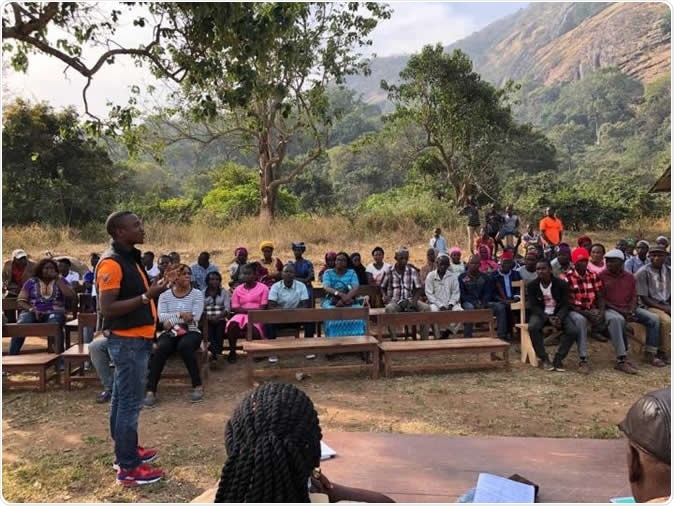The deadly Marburg virus has been detected for the first time in West Africa in Sierra Leone. A team of researchers have confirmed the presence of the virus in eleven Egyptian rousette fruit bats. These bats were found in three different health districts raising concern that the finding is not an isolated one. The researchers have confirmed the findings in the fruit bats and reported their results in the journal Nature Communications.

Scientists have detected Marburg virus in fruit bats in Sierra Leone, marking the first time the deadly virus has been found in West Africa. Following discovery of the virus in bats in three districts of Sierra Leone, the PREDICT-USAID team worked with the Sierra Leone government to inform people about his new health risk. This photo shows a community meeting in Kakoya village, northern Sierra Leone. Image Credit: Brian Bird / UC Davis One Health Institute
The Marburg virus is a close relative of the Ebola virus explain researchers. It may also lead to the deadly life threatening hemorrhagic disease in patients as seen with Ebola. Until now there have been no reported cases of Marburg infection in Sierra Leone say health officials. The detection in the bats however could signal the risk the local population might be at or getting infected.
These Egyptian Rousette bats are known to carry the Marburg virus. They feed primarily on fruits and are fruit bats. When the bats get infected, they pass on the virus in their saliva, urine and feces. These bats tend to urinate and defecate where they eat and take small bites of fruits before leaving them uneaten. This means that these bitten fruits are contaminated with the infected virus filled saliva and the food sources are also contaminated with infected bat urine and feces. Thus, the fruits become a potential source of spread of infection to animals and humans living around them. This causes the infection and its spread. The bats may also bite humans and thus spread the infection via their saliva.
For this study the researchers used a test based on PCR to detect the antibody as well as the virus within the fruit bats. The results of suspected cases among the bats were first announced in December 2018. Since then steps have been taken to ensure that citizens of Sierra Leone are warned about the danger of the infection. In addition, health organizations across the world were notified about the risk of infections to the local population.
This new study urges the key stakeholders including the health organizations, administration and other health bodies in the animal as well as environmental sectors to come together and help prevent the spread of this infection within the community. The researchers call for strategies that need to be developed to prevent the spread of the infection.
The virus was first detected by the Centers for Disease Control and Prevention (CDC) along with the USAID-funded PREDICT project. This project was led by the One Health Institute at the UC Davis School of Veterinary Medicine, Njala University, Sierra Leone and the University of Makeni, Sierra Leone.
Tracey Goldstein, co-principal investigator and pathogen detection lead for the PREDICT project from the UC Davis One Health Institute, in a statement said, “Finding Marburg virus in bats in Sierra Leone before any known cases in people is a huge success, as public health officials and doctors can now include Marburg virus among the possible causes when diagnosing hemorrhagic fever cases in the region.”
The world has witnessed 12 outbreaks of this virus say experts. These outbreaks have been regularly occurring with the last seen in Uganda in 2017. Scientists have said that the largest Marburg virus outbreak was seen Angola in 2005. In this attack an estimated 227 persons had died of the infection. In this new study the team found five new strains of the virus that are similar in their genetic make-up with the strains seen in the Angola outbreak. The team explained that this similarity with the Angola strain has been noted for the first time and it is cause for concern.
At present the team PREDICT is continuing its work in sensitizing the governments and other stakeholders to raise community awareness regarding the spread of the Marburg virus and ways to prevent spread of infection in Sierra Leone. Marburg virus disease has also been included in the routine testing panels of the laboratories in Siera Leone, write the researchers.
Amara Jambai, deputy minister of health for Sierra Leone, in a statement said, “PREDICT opened up the window to show there is more beyond Ebola and demonstrated the need for partnership well before outbreak events unfold.”
The public has been warned against attempting to kill or remove the bats by trying to catch them. They are being made aware of the ways in which the fruit bats help in agriculture and pollination and maintain the ecological balance. Protecting oneself from the infection would mean avoiding contact with anything the bats have contaminated and avoid getting bitten by the bats.
Brian Bird from the UC Davis One Health Institute and global lead for Sierra Leone and Multi-Country Ebola operations for PREDICT-USAID, in a statement said, “Over a year ago, we worked with our Sierra Leone government colleagues to inform people across the country as fast as possible of this new health risk and remind people not to harm or come in contact with bats. I'm very proud of that work and our teams now that this full report is available.”
Journal reference:
Amman, B.R., Bird, B.H., Bakarr, I.A. et al. Isolation of Angola-like Marburg virus from Egyptian rousette bats from West Africa. Nat Commun 11, 510 (2020). https://doi.org/10.1038/s41467-020-14327-8, https://www.nature.com/articles/s41467-020-14327-8